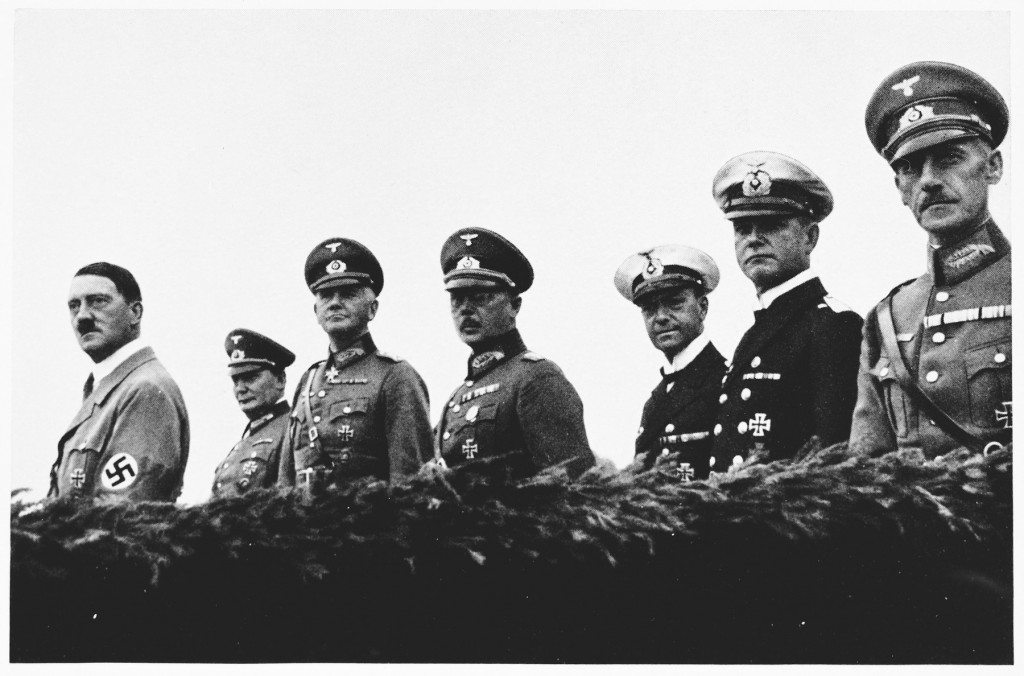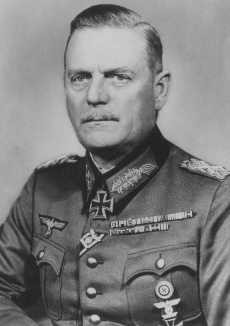
German Armed Forces High Command
Established in 1938, the German Armed Forces High Command was theoretically a unified military command controlling Germany’s air force, navy, and army. In reality, the establishment of the High Command allowed Adolf Hitler to consolidate power as commander-in-chief of the German military.
Key Facts
-
1
Despite its organizational structure, which included the High Command, the German military was micromanaged by Hitler.
-
2
Suspicious of the military and of its generals in particular, Hitler also employed monetary bribes to guarantee their current and future loyalty.
-
3
The High Command was deeply complicit in the Holocaust and other crimes of the Third Reich.
Overview
The German High Command, with Adolf Hitler at its head, directed Germany’s armed forces before and during the Second World War. Germany’s military leaders were central to Hitler’s rise to power, supported his desire for a war of conquest, and were complicit in the Holocaust and many other of the regime’s crimes.
Organization of the High Command
The German high command consisted of Adolf Hitler, the War Ministry—after February 1938, the Armed Forces High Command (Oberkommando der Wehrmacht, OKW)—and the high commands of the three services: the air force (Luftwaffe), the navy (Kriegsmarine), and the army (Heer). Despite its name, the OKW was not a unifying command organization; the other services maintained their independence, with the Army High Command (Oberkommando des Heeres, OKH) and its General Staff holding a dominant position.

Hitler occupied the top of the hierarchy. He was not just the Führer (Leader) of Germany, but also Commander in Chief of the Armed Forces (after February 1938) and Commander in Chief of the Army (after December, 1941). Other key figures were Wilhelm Keitel, Chief of the OKW; Alfred Jodl, Hitler’s primary military advisor in the OKW; Werner von Blomberg, Defense Minister and Commander in Chief of the Armed Forces until Hitler took over; Werner von Fritsch and Walther von Brauchitsch, Commanders in Chief of the Army until Hitler took on that role, too; and Ludwig Beck and Franz Halder, Chiefs of the Army General Staff. These men made the most important decisions regarding military policy and strategy, as well as playing key roles in political developments and occupation policies.
Political Developments, 1933–39
Like many people in Germany, its military leaders did not believe that the Allies had defeated the German army in World War I. Rather, the “stab in the back” myth arose, according to which Jews and Leftists in Germany took advantage of political unrest to betray the army and sign a treasonous peace treaty. The generals believed that another war was the only way for Germany to regain its honor, its economic prosperity, and its position as a world power. They also believed that the next war would have to be a total war, and that only an authoritarian government could unite the country and prosecute the war successfully. Hitler and the Nazis seemed to address that role, so the generals supported Hitler’s rise to power and his suppression of all other political parties. They also went along with measures that targeted Jews, since a strong strain of antisemitism ran through the military. Hitler, in turn, poured all the resources he could into rearmament, and began laying plans for the conquest of Europe.
Thus, the army, which was the only institution in Germany that could have opposed Hitler from an early stage, showed no inclination to do so. Hitler solidified his power still further in February 1938, when he dismissed Blomberg and Fritsch, while the army did nothing. Another crisis passed later that year, when Beck tried to organize resistance to Hitler’s plan to attack Czechoslovakia. Beck did not oppose war, but he did not believe Germany was ready for the conflict. No other generals would back him up, however, and he soon resigned. Halder, his successor, went so far as to consider a coup, again because he feared a premature war, but Hitler’s triumph at the Munich Conference took the wind out of his sails, and he never considered open rebellion again.
When Hitler ordered the invasion of Poland, the generals were in complete support of him. Like many Germans, they hated the Poles and considered the Polish state to be illegitimate. And so the war began, with the high command’s full support.
The High Command and the Crimes
The radicalization of Nazi racial policy that accompanied the onset of the war tested the limits of the army’s loyalty to Hitler. Ultimately, though, the army adjusted its limits.
From the start, there was cooperation between the army and the Nazi Party’s elite paramilitary wing, the SS. Before the invasion of Poland, the army provided the SS with lists of individuals who might resist German occupation. The SS made use of those lists to embark on a program to annihilate the Polish intelligentsia, including political leaders, priests, and even school teachers. Some senior army commanders objected, briefly and ineffectually, but for the most part, the army decided that this was a “political” matter in which it should not interfere.
The invasion of the Soviet Union in June 1941 brought the war and Nazi policy to their most radical phase. Well before the invasion, the OKW and the OKH, working from Hitler’s general guidance, planned a campaign of persecution, exploitation, and murder that is unparalleled in modern history. No German soldier’s crime against a Soviet civilian would be cause for prosecution. Soviet political officers were to be shot immediately upon capture. Any civilian who was suspected of resisting in any way was also subject to shooting. Jews and Communists were special targets, simply because of who they were (to the generals, a Jew equaled a Communist, equaled a partisan). The army and the SS drew up agreements by which Einsatzgruppen and other mobile killing squads would follow along behind the army, shooting Jews and Communists, with the army providing logistical support. The OKH and the Reich Food Ministry also agreed to take foodstuffs from the USSR in quantities that would condemn millions of civilians to starvation. And the OKW, which was in charge of prisoner of war (POW) policy, deliberately neglected to prepare for the millions of men the army would capture.
The results of these policies were catastrophic. The murder squads shot and gassed between 1.5 and 2 million people by the end of 1942: most victims were Jews, but Communists, people with disabilities, and suspected partisans were also murdered. Over 2 million POWs and untold numbers of civilians died from starvation, exhaustion, exposure, and disease. Millions more were put to forced labor in tens of thousands of camps throughout Germany and the occupied territories. Hundreds of villages, towns, and cities were deliberately laid waste.
When it was all over, the leading generals tried to claim that they had nothing to do with the crimes, that they had never received such orders, even that they had resisted. They fought with honor against a vicious foe, they said. The evidence, however, is overwhelming. They knew about genocide and Nazi atrocities; they approved it, and they encouraged it. The German High Command cooperated fully in the Nazis’ genocidal program, even if the generals liked to pretend they were not Nazis.
Critical Thinking Questions
How did the role of the German military change during 1933-1945? Why?
How were the orders for the eastern front different than previous orders for campaigns in the west? How do you account for this difference?
What was the accountability of the High Command for these changes?
Have military codes and the Laws of Armed Conflict changed since World War II? How and why?

